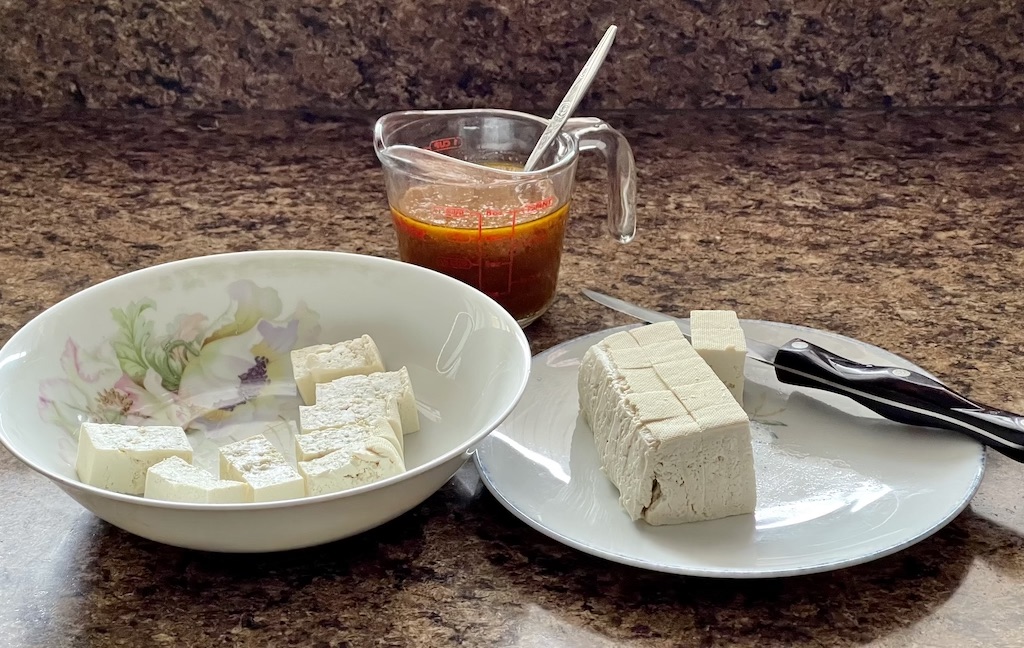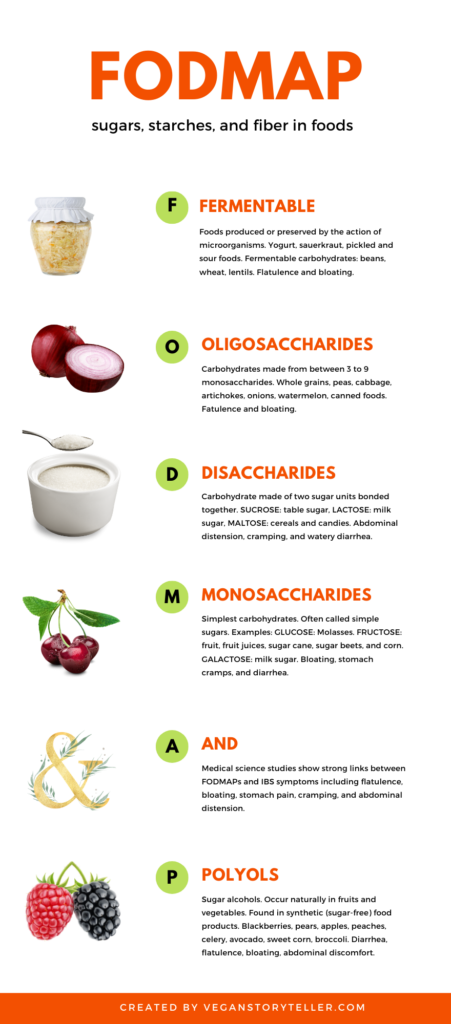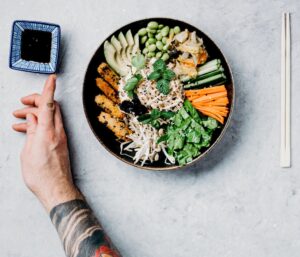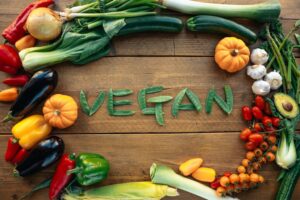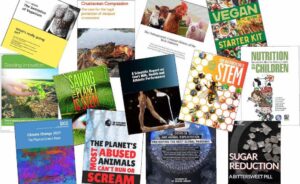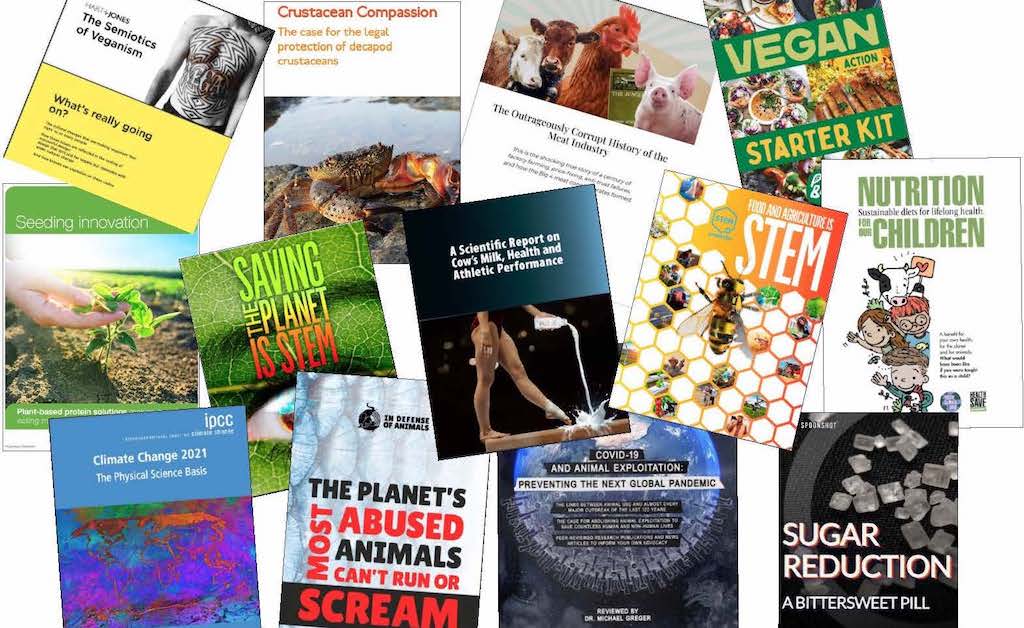What does tofu taste like? is the first question most people have about tofu. Beginner vegans generally follow up with the question Is tofu vegan?
These questions are followed by a stream of others, such as “Where can I buy tofu? Can I freeze tofu? Is tofu healthy? What’s the difference between tofu and soy? What is tofu anyway?”
Keep reading. Everything you have ever wanted to know about tofu is answered in this complete guide to tofu.
TABLE OF CONTENTS
Is tofu vegan?
Has tofu been genetically modified?
What does tofu taste like?
Finding tofu recipes
Giant Book of Tofu Cooking
Can people with IBS eat tofu?
FODMAPs defined
How much protein is in tofu
To be healthy, how much tofu is safe to eat?
Testing on animals to determine hazards of estrogen in soy
Shopping for tofu
Types of tofu
Packaging and what to look for
Preparing tofu before you cook it
Eating tofu raw
Storing tofu
Freezing tofu
Signs that your tofu has gone bad
Health benefits of tofu
Heart disease
Cancer
Menopause
Osteoporosis
Other products made from soybeans
Is tofu vegan?
Let’s start with the basic question that most beginners to veganism have: Is tofu vegan?
Yes. Tofu is a purely vegan food. It’s not a vegetable, but it is definitely vegan. Tofu is a protein staple for a plant-based diet. It is made from soybeans and comes from a legume. The word itself is Japanese and means bean curd.
The method for making tofu hasn’t changed in more than 2,000 years. There are three ingredients in tofu: soybeans, water, and a coagulant. The coagulant is either nigari, a compound found in natural ocean water, or the natural mineral calcium sulphate (gypsum).
Has tofu been genetically modified?
Most soybeans grown in the U.S. are genetically modified. Genetically modified organisms (GMO) are created when the genetic code of a plant, or organism, is altered. Genes from one species are transferred to another, creating something that would never exist in nature.
Discussions about GMOs generally focus on economic, environmental, and human health issues. The topic of animal testing is missing from the conversation. Countless rats, monkeys, dogs, and other laboratory animals suffer and die in toxicity tests that scientists conduct when developing genetically modified plants. Ethical vegans — those of us who are opposed to harming or exploiting animals in any way — need to know this about GMOs.
Our buying choices matter. The welfare of animals is worth the few extra coins it takes to purchase organic tofu. In addition to soybeans, the U.S. has approved 10 other plants for genetic modification: alfalfa, apples, canola, corn, cotton, papaya, potatoes, summer squash, and sugar beets. Buy only organic tofu and other foods so that you don’t inadvertently support animal testing. In my opinion, there are further reasons to avoid bioengineered foods, but that is a topic for another day.
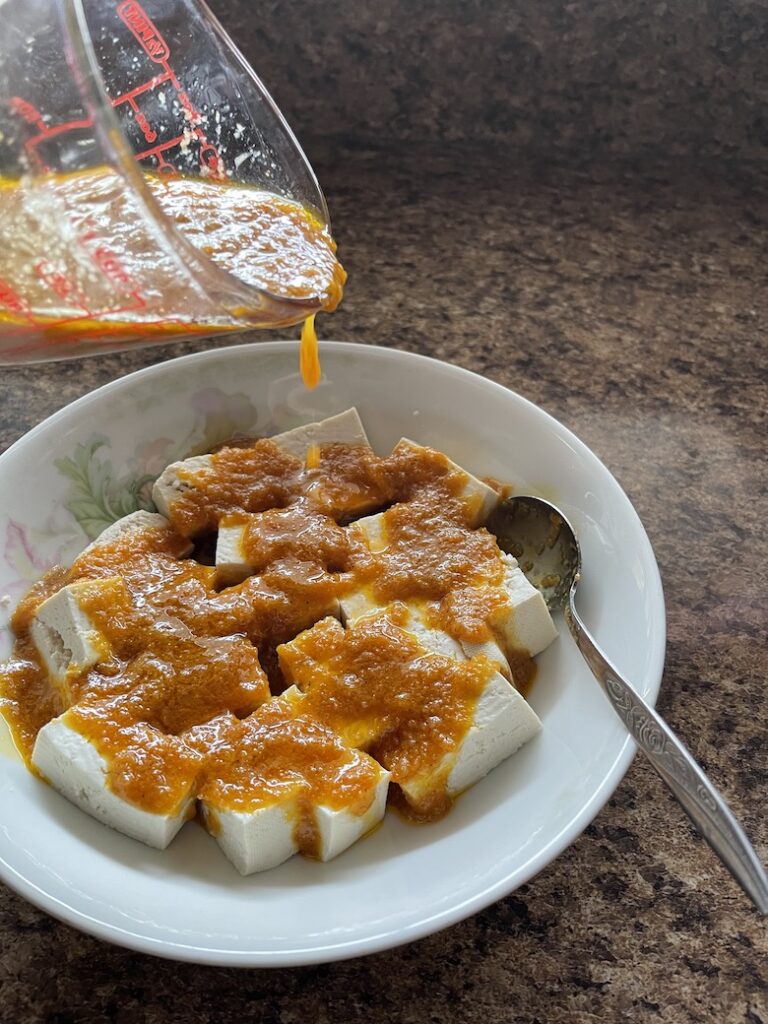
Photo by Jeanette McDermott
What does tofu taste like?
Soybeans are a dominant feature of plant-based diets, which continues to be of interest and focus to consumers. The answer to the question most people are curious about — what does tofu taste like — is simple. Straight from the container, unadorned tofu is bland, if not tasteless. It has a distinctive texture, but when it comes to taste, it won’t register on your palate.
This is actually good news because you can make tofu taste however you want it to taste. The versatile nature of tofu appeals to cooks, chefs, and other foodies who like to experiment in the kitchen. A bland and spongy block of tofu becomes a flavorful and chewy grilled soy steak when it absorbs the flavors of oil, herbs, spices, and marinades.
Even non-foodies who have no patience in the kitchen have success with tofu since it is incredibly easy to cook with. There is a cookbook I recommend if you want easy tips on how to prepare and cook tofu.
Finding tofu recipes
A quick internet search will overwhelm you with tofu recipes. I find it much easier and quicker to pull a single tried-and-true source from a kitchen library than to search for recipes and information online. It’s also more enjoyable.
My work in communications requires me to spend entire days on the computer. I like to get away from screen time whenever I can. Searching for a recipe online feels like additional work. Thumbing through a colorful cookbook in search of a recipe feels like an enjoyable hobby.
I’m not alone in this pursuit. A whopping 21.5 million print cookbooks were sold in the US in 2020. Cookbooks are so popular that some bookstores specialize in selling only cookbooks. Thankfully, digital has not rendered cookbooks obsolete. I hope it never does.
Giant Book of Tofu Cooking
The Giant Book of Tofu Cooking was published in 2000. I bought it the year it was released and have used it extensively to make tofu recipes. The book is still in print, and you can buy it online for less than $5.
The plant-based cookbook is more than a collection of 350 vegan and vegetarian recipes. A beginner vegan who is new to bean curd can learn the basics of tofu in the book. When you’re unfamiliar with an ingredient, like galangal and mirin, the book’s ingredient glossary comes in handy.
The cookbook includes a metric conversion chart and a well organized, catalogued index. It’s a treasure trove of instructions and knowledge, starting with the basics.
The cookbook is categorized by sections for breakfast, lunch, and dinner; dressings, sauces, and spreads; and, of course, desserts. It has both vegan and vegetarian recipes. Each recipe lists tofu as the first ingredient, along with the suggested type of tofu to use (soft, extra firm, etc.) and tips for how to prepare it. The recipes require no guesswork. They are quick and easy to prepare, which is great for beginner vegans or anyone new to tofu.
I was vegetarian when I bought the Giant Book of Tofu Cooking nearly 22 years ago. A decade later I went vegan. I have used this cookbook consistently throughout my journey from vegetarian to vegan. I still find the cookbook to be highly useful, as evidenced by its smudged and raggedy cover and dog-eared pages.
Can people with IBS eat tofu?
FODMAPs are a group of sugars (carbohydrates) that can’t be absorbed in the small intestine. The carbohydrates pass directly through to your colon undigested, where they ferment.
The bacterial and gas buildup in the bowel causes havoc for people who have Irritable Bowel Syndrome (IBS), causing painful symptoms that are both embarrassing and physically distressing. A few of the digestive disorders that plague vegans with IBS include gut noises and bowel distention, abdominal and rectal cramping, diarrhea, bloating, flatulence that could stop a charging rhino, and constipation.
All edible plants contain FODMAPs. Trying to figure out which foods trigger IBS symptoms is not easy for people who live on a plant-based diet.
Thankfully, most vegans can eat tofu without fear of triggering IBS symptoms. Regular, firm, and extra firm tofu have low amounts of sugars and are, therefore, low-FODMAP foods. Silken tofu, on the other hand, contains high amounts of fructans and GOS, which are high FODMAP.
“It’s not possible to have an entirely FODMAP-free vegan diet because virtually all plant foods contain some measure of FODMAPs. We can, however, center our diets around foods that contain minimal amounts of FODMAPs,” says Jo Stepaniak in her book Low-FODMAP and Vegan.
Vegans with IBS should tread gently with high FODMAP foods, like silken tofu. To prevent upsetting the gut, only consume small amounts per meal.
Stepaniak’s book Low-FODMAP and Vegan: What to Eat When You Can’t Eat Anything is an excellent resource for vegans who have IBS. The book includes easy-to-read tables and shopping lists that arm readers with the information they need to navigate the supermarket and purchase foods that are kind to the gut. It also contains more than 100 recipes for delicate digestive systems. It’s one of the books I keep close at hand in my kitchen library and consult frequently.
FODMAPs defined
FODMAP is an acronym that stands for
- Fermentable
- Oligosaccharides (fructans and galacto-oligosaccharides, also known as GOS)
- Disaccharides (lactose)
- Monosaccharides (fructose)
- And
- Polyols (polydextrose, isomalt, maltitol, mannitol, sorbitol, and xylitol).
Monash University in Melbourne, Australia developed the concept of FODMAPs and was the first group to measure them in food. FODMAP tolerances vary from person to person; however, research at Monash University has shown that 75% of people with IBS benefit from a low-FODMAP diet.
An app from Monash University helps people with IBS keep track of FODMAPs. I use the Monash app every day. Find out more about FODMAPs and watch Monash’s animation to learn how FODMAPs can trigger IBS symptoms.
As a quick disclaimer, I’m not an affiliate marketer. I receive no monetary rewards for recommending cookbooks or apps on this blog, other than the positive vibe I feel passing along what I find to be helpful in my own vegan journey.
How much protein is in tofu?
Protein is traditionally thought to come from either meat or vegetables. Among vegans, plant-based protein is the only source of protein. The stereotype that vegans can’t get enough protein from plants has long been disproved.
It is unquestionable that tofu is a complete source of protein that contains all of the essential amino acids for human nutrition. Many health and nutrition experts now recommend low-fat soy protein over high-fat animal protein.
A typical block of tofu (122g ) contains 15.6 grams of protein. The more dense the tofu is, the more protein it contains. Tofu is rich in iron and calcium and the minerals manganese, selenium and phosphorous. It’s also a good source of magnesium, copper, zinc, and vitamin B1. It is low in saturated fats and calories.
To be healthy, how much tofu is safe to eat?
You can eat soy daily and feel good about the nutrition you are putting into your body to stay healthy. Based on clinical studies, recommendations for adult intake of soy protein is 15-25 grams per day, or 2-4 servings of soy foods per day.
Simple soy products such as tofu, edamame, miso, and tempeh are better for you than processed meat alternatives. A single serving size of tofu is 150 grams or ¾ cup. One block of tofu weighs 122 grams.
For many years, people thought soy added too much estroggen to the body and linked soy to breast cancer in women. But much of the research that raised the concern looked at the effects of soy on rodents used in experimental labs. These animals process soy differently than humans do.
The controversy of soy and estrogen was dispelled according to WebMd, which states on its website, “Studies with people show that tofu doesn’t have enough plant estrogens to cause breast cancer.”
Testing on animals to determine hazards of estrogen in soy
Evidence such as this shows that animals are not as critical to the advancement of medicine as proponents of animal experimentation claim. And yet, the inhumane and unethical practices continue.
Sentient Media has published an article on the ethics of animal testing, reporting that “Over 100 million animals including dogs, cats, monkeys, mice, and rats are burned, poisoned, abused, and crippled in labs in the U.S. each year. They are deliberately made sick with toxic chemicals, infected with diseases, and live in barren cages until they eventually die.”
When researching specific medical or dietary topics related to soy, be sure to consult reputable medical sites that have been peer-reviewed and contain footnotes with citations. Talk to your doctor if you feel confused, conflicted, or misled by the information you find online.
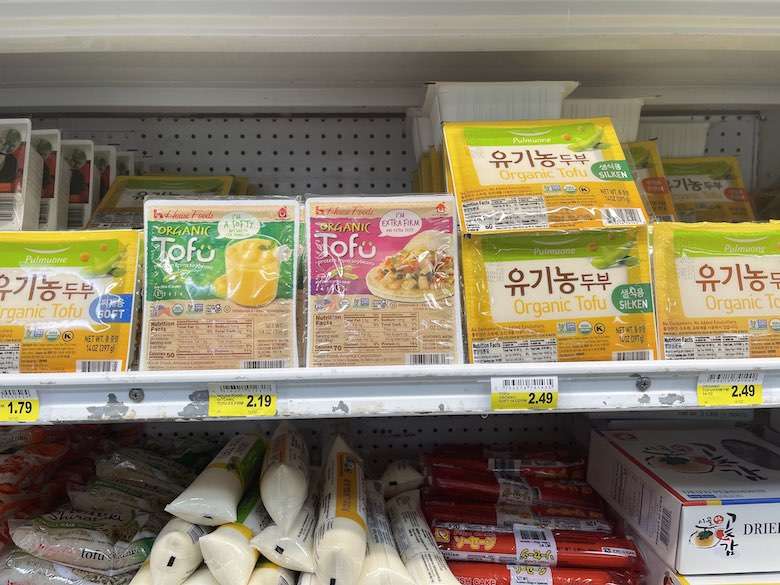
Photo by Jeanette McDermott
Shopping for tofu
If you are new to tofu and have never bought it before, you may feel overwhelmed walking into an Asian market, health food store, or other grocer trying to figure out what type of tofu to purchase.
Asian markets and many grocery stores sell soft, silken, firm, extra firm, freeze-dried, marinated, fermented, fried, baked, and smoked tofu. There are also tofu products that are prepared and ready to eat.
The recipe you want to make will determine the type of tofu you need to buy. The Giant Book of Tofu Cooking lists as the first ingredient the type of tofu that’s needed for each recipe. If you know the type of tofu a recipe calls for, you can shop for it.
Types of tofu
Density is what determines tofu type and impacts how it holds up in food preparation. Density varies from soft and creamy silken tofu to thick and chewy extra firm tofu The denser the tofu, the more protein and fat it contains. Understanding density will allow you to choose the right type of tofu for your recipe. There are four general types of tofu:
- Soft tofu has a spongy texture that is used for blending, mashing, and crumbling.
- Silken tofu is soft, smooth, and creamy and is generally used in smoothies, soups, puddings, and savory dips.
- Firm tofu holds up well when baked or stir fried.
- Extra firm tofu contains the most protein and won’t fall apart on the grill.
Aside from the four general styles of tofu, you can find tasty and convenient prepared tofu products that you can enjoy right away or pan-heat to enhance the flavor. They are particularly good for sandwiches and salads.
Prepared tofu is widely available in Asian markets, but less so at the average grocery store.
- Marinated tofu is flavorful and ideal for quick meals when you don’t have time to prepare tofu from scratch.
- Smoked tofu is chewy and has a smoke-grilled aroma and flavor.
- Freeze-dried tofu is best used with marinades and sauces and is perfect for camping and backpacking.
Again, remember the question asked earlier — What does tofu taste like? Tofu is tasteless until you add marinades, smoke, and other flavors for it to absorb.
Packaging and what to look for
If you’re new to tofu and don’t know what to look for, shopping for tofu can be overwhelming. These tips will help you navigate through the grocery aisles.
- Covered in water and sealed in a white plastic tub: The most readily available tofu sold is covered in water and sealed in a plastic tub. It usually comes in 12 or 16 ounce blocks. Most brands are pasteurized, and all tofu is perishable. You will find this product in the refrigerated produce or dairy section of a grocery store or Asian market.
- Hermetically sealed: Tofu that has been marinated or smoked is hermetically sealed in thick transparent plastic. This product is also found in the refrigerated section of the market.
- Packaged aseptically in a carton: Some types of tofu are packaged aseptically in a carton, which means they have been thermally sterilized. If you buy tofu in an aseptic container, you can store it on a shelf until opened. You might find aseptically packaged tofu in the refrigerated section of a market or on grocery shelves. If you purchase it from the refrigerated section of the store, then you need to keep it refrigerated at home. As soon as the carton is opened, you must refrigerate the tofu and use it within 3-5 days.
- Fermenting in a jar: Fermented tofu is found in jars and tins on shelves in specialty Asian markets. Fermented tofu is a probiotic that promotes healthy gut flora. In 2017, PubMed published a report touting the health benefits of fermented soy products.
Always check the expiration date before buying tofu. Fresh tofu has a slightly sweet smell and is visibly appealing. If you open the package and the tofu smells sour or appears to have a tint of pink or green, don’t eat it.

Photo by Jeanette McDermott
Preparing tofu before cooking it
Tofu is porous and has a high water content. In order for it to absorb flavors or get chewy and crispy when cooked, you first have to drain, blot, and press it to remove as much moisture as possible. Some recipes call for freezing and thawing tofu to make it even more porous so that it can absorb flavors even better.
There are three steps you should take to release excess moisture from tofu before using it in a recipe:
- Drain the tofu
- Blot the tofu
- Press the tofu
You want to make sure the tofu you are using in a recipe contains as little water as possible before using it in a recipe. That means draining the tofu once you take it out of its container. Set the tofu in a colander or other type of drainer to allow the water to run off. Then, blot the tofu with a clean cloth or paper towel to absorb additional moisture.
As a final step, press the tofu to get the last bit of water out of it. Do this by placing a weighted object on top of the tofu, like a pan or skillet. You can also press the tofu between two small plates. I like this method because it’s quick. But take it easy on the tofu. I obliterated an entire block of tofu in a matter of a few short seconds by squeezing the plates too hard. Tofu collapses easily when treated with heavy-handedness.
There are many kitchen gadgets you can purchase to press tofu, but using what you have on hand works just fine and costs no additional money.
After the tofu is drained, blotted, and pressed, it’s ready to blend, dice, cube, slice, crumble, marinate, boil, fry, sauté, shred, or grill. You get the idea. Tofu is versatile. The sky’s the limit when it comes to cooking with tofu. Remember that the recipe determines what type of tofu you need to buy, so decide on your recipes before going shopping.
You can also eat tofu raw.
Eating tofu raw
Tofu is already cooked when you buy it. The process of making tofu starts with boiling soybeans into a milk substance and then adding thickening agents, called coagulants, to shape the tofu into blocks or cakes. Because it’s already cooked, you can eat tofu straight from the package in its “raw” state. Raw tofu is a great base for smoothies and homemade ice cream.
Although uncommon, tofu may cause foodborne illness if it was processed on unclean equipment, or if employees sneezed or coughed on it, or if they handled it with unwashed hands.
Some types of tofu are stored in water. This could make it possible for cross contamination through germs in the water. Tofu may also become contaminated by bacteria and mold if it stands in the same water for too long once it has been opened or exceeded its expiration date.
Be careful of contamination
Avoid purchasing tofu that is stored in batches in a large bin of water and sold in bulk. The water could grow bacteria if not changed frequently enough, and people could infect the water with unwashed hands. Never slice, dice, or cube tofu on a cutting board that has been used to prepare raw meat or fish.
To minimize the risk of food poisoning, store tofu according to package directions. Use clean utensils, cutting boards, and containers to avoid cross-contamination. Always wash your hands before preparing tofu and other foods, and never sneeze or cough over your food.
Storing tofu
Be sure to keep tofu in its original package until you’re ready to use it. And always use it before the expiation date. The shelf-life of tofu can vary, ranging from 1 to 5 days for fresh tofu, 3 weeks to 1 month for pasteurized tofu in the package and 6 months to 2 years for tofu processed aseptically. To a large extent, the initial microbial load and storage temperature govern the shelf-life.
Refrigerate any unused tofu in fresh water in a closed container to prevent it from drying out or absorbing flavors of other foods. You can keep unused portions of tofu stored in the refrigerator for up to one week, but change the water at least every other day to prevent bacterial growth. Store in glass or BPA-free plastic.
Aseptically packaged tofu can be stored for months and doesn’t require refrigeration until after it is opened. But be sure to consume or freeze aseptically packaged tofu within three days after opening the package. Also, if you purchase aseptically packaged tofu from the refrigerated section of a market, then store it in the refrigerator at home.
NOTE: Use only freshly opened tofu for smoothies and desserts, or in any other recipe that doesn’t require cooking.
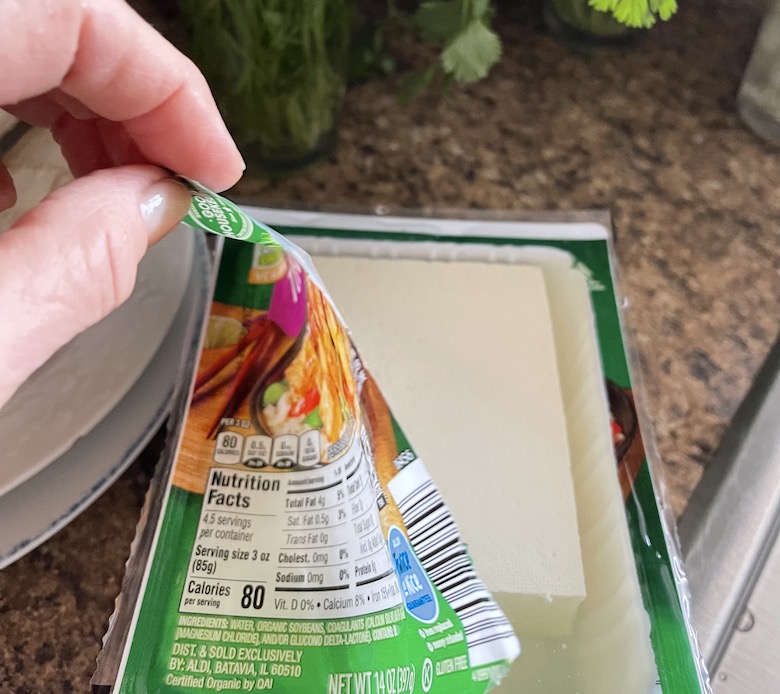
Photo by Jeanette McDermott
Freezing tofu
Freezing tofu is no problem and is even preferred by some people. People generally freeze tofu for two reasons: to increase its shelf life and to change its texture.
You can freeze firm and extra firm tofu in their unopened packaging for up to three months. Freezing removes excess moisture and allows tofu to better absorb flavors from marinades and sauces. It also makes the tofu more chewy so it doesn’t fall apart when grilled or fried.
There are some drawbacks to freezing tofu. Frozen tofu doesn’t crumble so forget about using frozen tofu in a tofu scramble or tofu tacos. Soft and silken tofu becomes rough and flaky in the freezing process and loses its creamy-soft texture.
Don’t re-freeze thawed tofu. Freeze it just once. If you don’t use a lot of tofu all at once, you could consider freezing it in small batches and then thawing only the amount you want to cook.
More about freezing tofu
Don’t freeze tofu in water. You need to drain it first and then freeze it.
- Unwrap the block of tofu and discard the water.
- Wrap the tofu with paper towels or a clean kitchen towel and place it on a flat plate or a cutting board.
- Use a heavy bowl or any other weight available in the kitchen to press the tofu block, and let it drain for at least 15 minutes.
- Wrap the drained tofu block with plastic wrap and place it in a freeze-proof container. You can also place the tofu in a freezer bag.
- Store the tofu in the freezer for up to three months.
To thaw the frozen tofu, remove it from the freezer, and place it in the refrigerator overnight. You can also thaw it at room temperature. Be sure to drain the thawed tofu before cooking it. You can also freeze cooked tofu. Just thaw it out or reheat it when you’re ready to eat it.
Signs that your tofu has gone bad
What does tofu taste like, smell like and look like when it has gone bad? There are a few tell-tale signs that will warn you when tofu is past its prime and shouldn’t be eaten.
- See: Tofu takes on a tinge of pink or green mold when it has gone bad. It gets wobbly and watery looking and curls at the edges.
- Smell: Tofu has a sour stench when it has gone bad.
- Taste: Tofu tastes bitter or sour when it begins to rot.
Don’t eat tofu if it doesn’t look, smell, or taste fresh.
Health benefits of tofu
There’s more to tofu than taste and versatile cooking. Tofu is known to lower the risks for heart disease, cancer, and according to some research, even Alzheimer’s. In Asia, where tofu and other soy-based foods dominate diets, there is less incidence of chronic disease. The rates of breast cancer and cardiovascular disease are four times lower than in the United States.
Tofu can help several health concerns: coronary heart disease, osteoporosis, prostate cancer, colorectal cancer, memory and brain health, weight loss, better skin, and bone health.
Keep in mind, however, that, like anything in life, what is good for some people, may not be good for you. Some doctors advise people to avoid tofu if they take medicines called MAOIs (monoamine oxidase inhibitors) for mood disorders or Parkinson’s disease. Tofu contains tyramine, an amino acid that helps balance blood pressure. MAOIs block the enzyme that breaks tyramine down. Combine the two and your blood pressure could get dangerously high, according to some reports.
Heart disease
Soy foods are high in protein but low in saturated fat and free of cholesterol. Clinical studies have shown that eating tofu or other soy protein significantly reduces the risk of heart disease.
Soy protein has the ability to dramatically lower the undesirable low-density lipoprotein blood cholesterol (LDL) levels within the body while raising the desirable high-density lipoprotein levels (HDL).
It takes at least 25 grams of soy protein per day in a low-fat, low-cholesterol diet to achieve a 10 percent reduction in cholesterol. That 10 percent decrease in cholesterol reduces the chance of having a heart attack by an astounding 20 to 30 percent.
Cancer
Isoflavones are found almost elusively in soybeans. Scientific studies have shown a strong connection between isoflavones and a reduced risk of many types of cancers, including breast, colon, lung, prostate, skin, and leukemia. It appears that as little as one serving of soy foods a day may be enough to obtain the benefits of isoflavones.
In a nutritional review on PubMed.gov, there is intriguing evidence indicating that when soy is consumed during childhood and/or adolescence, risk of developing breast cancer is markedly reduced.
Menopause
Isoflavones have also been linked to a decrease in symptoms related to menopause. Studies have shown that menopausal women who ate soy had almost 50 percent reduction in hot flashes night sweats, and other menopausal symptoms.
Osteoporosis
Characterized by weak and brittle bones, osteoporosis affects an alarming number of post-menopausal women. Calcium is one of the many preventive factors that can slow down loss of bone matter and even increase overall bone density. The isoflavones found in tofu help make it easy for the body to absorb and utilize calcium.
PubMed.gov covers the topic of the health benefits of isoflavones in depth. PubMed was developed and is maintained by the National Center for Biotechnology Information, at the U.S. National Library of Medicine, located at the National Institutes of Health.
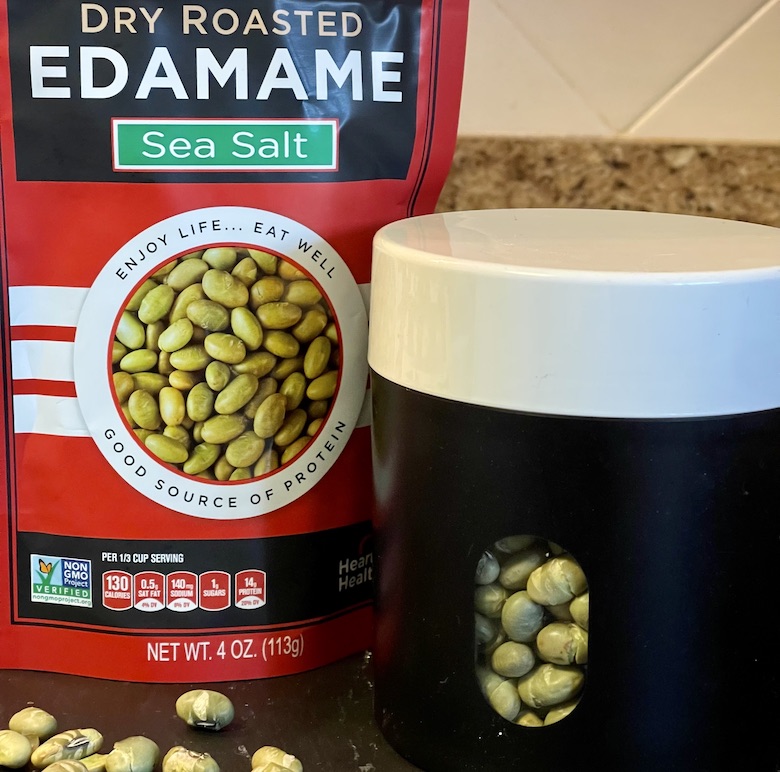
Photo by Taio Sweet-Starseed Family Productions
Other products made from soybeans
We know what tofu tastes like, but what about other soy-based products? Tofu is just one of many products made from soybeans. The list of soy-based products is long. Here is a sampling of what you can find.
Edamame is firm and tastes good. The green soybeans make a nice snack and addition to stir-fries, salads, and soups.
Soy meat alternatives are made with tofu, tempeh, textured soy protein, or soy flour. They are low in fat and cook quickly.
Miso is a salty paste that is made from fermented soybeans. It is used mostly as a soup stock.
Natto is a traditional Japanese dish that is made from fermented soybeans. It is loaded with protein and micronutrients and improves gut flora and nerve function. It’s salty and has a funky gooey texture.
Soy cheese is made from soybeans, but vegans beware; some varieties include casein, a cow’s milk protein that gives the soy cheese a dairy flavor and helps it melt when heated. Soy cheeses come in an abundance of flavors and brands, which all taste different from one another.
Soy flour is made by toasting soybeans and then grinding them into a fine powder. It is a great source of protein and is high in fiber.
Soy ice cream, like its cashew, coconut, and tapioca flour counterparts, is a non-dairy alternative to ice cream.
Soy milk is made from soybeans that have been soaked, ground fine, and strained. It is easy to make yourself. It has a mild flavor.
Soy sauce is made from fermented soybeans and is used as a flavoring to enhance stir-fries and other Asian dishes. A little bit goes a long way due to its high sodium content.
Soy sprouts are crisp sprouts of germinated soybeans that are high in protein. They are generally found in Korean grocery stores.
Soy yogurt is thick and creamy and made from soy milk. It comes sweetened with sugars and fruits and unsweetened and plain.
Soynut butter is a peanut butter substitute made from roasted whole soybeans. It is tasty and has less fat than tree nut butter.
Soynuts are soaked soybeans that are baked until browned. The flavor is similar to peanuts.
Sufu or furu is a fermented soybean product from China. The fermented soybeans are aged in brine and alcohol, which gives them a creamy cheese-like consistency. It is generally eaten as an appetizer or side dish with rice or steamed bread.
Tempeh is a chunky, tender soybean cake that has a distinctive nutlike flavor. It’s cold fermented with a variety of grains mixed into it, such as quinoa and barley.
Textured soy protein is made from soy flour, and has all of the protein, fiber, and isoflavones of other soy products.
Whole dry roasted soybeans provide isoflavones, which provide cardiovascular benefits. They are a powerhouse of protein, healthy fats, and essential vitamins and minerals, including B-12, folate, and vitamin K.
Yuba The coagulated top of simmering soy milk is hung and dried to produce yuba, a high protein food. The rubbery sheets are used in Asian recipes to mimic duck or chicken. You can buy it fresh or dried in Asian markets. Rehydrate dried yuba before cooking with it. Yuba, like tofu, has a bland taste and absorbs the flavors of what it is cooked with.

